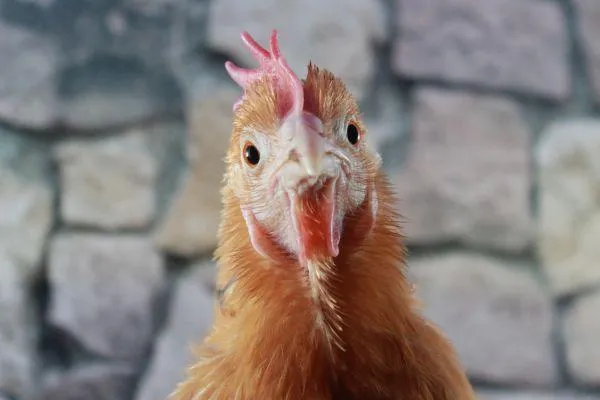
Non-infectious diseases in poultry
Many of the diseases that can cause problems in farmyard poultry are the result of infections by parasites, bacteria, or viruses, but there are many other types of problems too. These are generally related to diet or management, and most can be readily prevented.
Here are some of the most common non-infectious health problems that could occur in your flock. For a solid grounding in poultry care, explore our chicken course.
Egg peritonitis
This condition occurs when the contents of the oviduct are forced out into the abdomen and infection develops.
It can develop after a blow to the abdomen or after an infection.
Affected birds almost always die.
Prevention involves minimising the risk of hens bumping their abdomen as they enter nest boxes, and preventing hens from being startled e.g. by dogs.
Prolapse
Occasionally hens can suffer from a prolapsed oviduct.
In this condition, the end of the reproductive tract is pushed inside out and protrudes from the vent (cloaca).
Often the cause is a very large egg in a young hen, and the prolapse is caused by straining.
The blood-covered mass is usually pecked at by other hens and this will continue until she is killed or rescued.
As soon as prolapse is spotted, gently clean and push the prolapse back, then allow the bird to recover alone in a quiet safe place.
The condition often recurs, so euthanasia is generally the most sensible option.
Egg binding
Egg binding occurs when a developing egg becomes stuck in the oviduct.
It can be difficult to detect unless hens are observed closely for signs of straining and failure to lay an egg.
Rubbing lubricating oil well into the vent can sometimes help.
By inserting a finger it may be possible to break the egg and very gently ‘milk’ the fragments of shell out without damaging the lining of the oviduct.
Egg binding is sometimes a forerunner to egg peritonitis.
Poisons
Because of their fossicking habits, free-ranging chickens are very susceptible to poisoning.
There are many potential poisons in the environment, including:
Some plants (ragwort, yew, nightshade)
Vermin poison (particularly anticoagulant)
Fertilisers (e.g. organophosphate)
Insecticides
Bacterial toxins (e.g. botulism) and algal poisons (e.g. toxic bloom in stagnant water)
Formalin (in livestock footbaths)
Copper (used in livestock footbaths and sprays for fungi on fruit trees)
Selenium (from top-dressing prills)
Lead in paint on the walls of old sheds
Fungal toxins (mycotoxins) in mouldy grain
Cannibalism
Cannibalism occurs when birds peck at the feathers, toes, heads, and vents of other birds.
If there is bleeding, this induces further pecking that can lead to the death of the bird.
Vent pecking occurs often in laying hens.
Young hens, especially if they are overweight, are susceptible to prolapse (the oviduct does not retract after the egg is laid), which induces pecking in the vent area.
What causes cannibalism
Stress is one factor, especially the stress of overcrowding, overheating, bright lights, or sheer boredom.
Dietary deficiencies such as salt, vitamins, or protein can contribute, as can insufficient feed.
Cannibalism shouldn’t be a problem in well-managed free-range farmyard flocks.
Treatment
Wounds can be treated with gentian violet or Stockholm tar to discourage pecking.
Injured or cannibalised birds should be removed from the flock for a period of time to allow their wounds to heal.
Prevention
Allow the birds more space
Ensure good ventilation and avoid bright lights
Offer several feeds of greens during the day or scatter grain to reduce boredom
Adding a rooster to the flock can help keep hens in order
Reduce light intensity and duration (but not for laying hens)
Red lights may help in some cases
Protein deficiency
When the birds’ feathers grow sparsely, and there are no feathers on the ground, there may be protein deficiency.
The diet should be improved to ensure sufficient protein.
Calcium deficiency
If there is insufficient calcium in the diet of layer hens, their eggs may be thin-shelled, and they may have thin brittle bones.
Offering oyster-shell grit or sprinkling their feed with horticultural lime flour usually corrects the problem.
Rickets
Rickets can occur in young birds due to insufficient vitamin D3, calcium, and/or phosphorus.
Commercial feeds and supplements usually provide these nutrients, but over-dilution can result in deficiency.
Birds can synthesise vitamin D to a certain extent with exposure to sunlight.
Vitamin A deficiency
Vitamin A deficiency generally shows up in autumn, because birds obtain vitamin A from green feed in the summer and can store it for a short period of time in the liver.
Once the green feed is gone, they can become deficient unless they are getting a balanced diet.
Signs include staggering, thinness, paleness, and blindness.
Blood spots may also be seen in eggs of laying birds.
Early cases recover when cod liver oil is added to the diet.
Metabolic diseases
There are various types of metabolic disease including:
Sudden death syndrome, usually affecting big young male chicks from 1 to 3 weeks old
Ascites or water belly, often linked to rapid growth, cold temperatures during brooding, high altitudes, excess dietary salt, excess dust or ammonia, and/or genetics
Crippled legs and lameness in meat-type birds due to rapid growth
These are most common in commercial broiler strains but can occur in backyard meat birds too.
Mild feed restriction can help prevent these disorders by slowing the growth rate of young birds.
Next in series: Treatment of disease in backyard flocks

